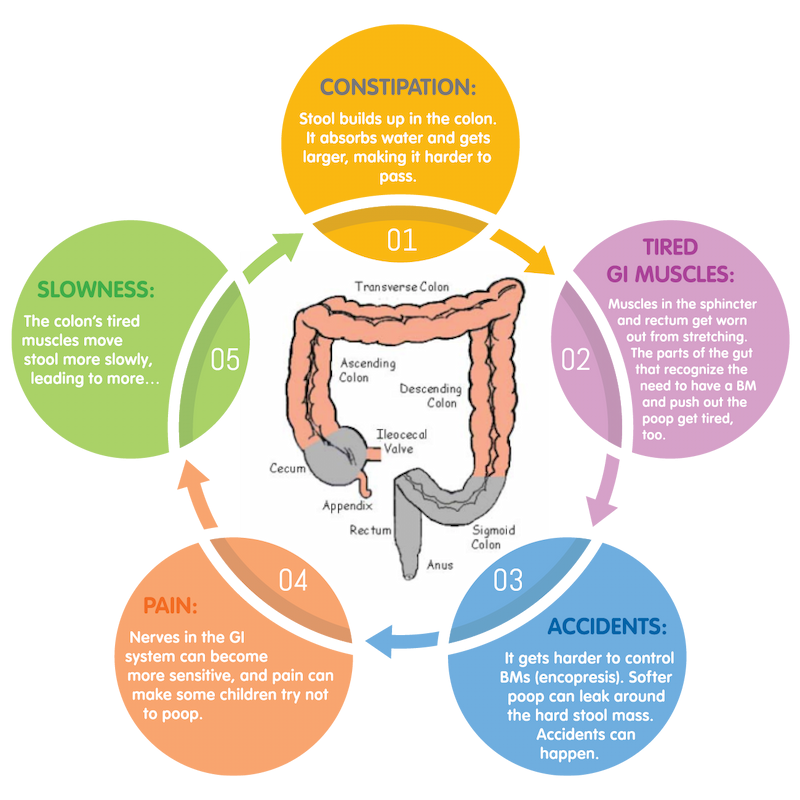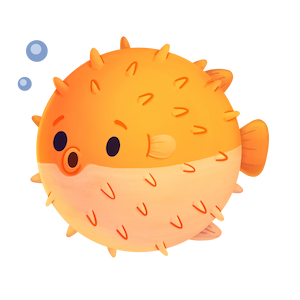Unstuck: Your Family’s Guide to Childhood Constipation

Feeling stuck?
If your child is having trouble pooping, it could be constipation.
Constipation shows up differently for different kids. Some experience large or painful stools. Some have small and rock-hard poops. And some have difficulty passing stools.
Having regular No. 2 accidents can also point to constipation.
Encopresis, or unintentionally pooping, can be a symptom of constipation, too. Long-term constipation can make it harder to control bowel movements (BMs). These messy accidents aren’t usually voluntary. Ninety percent of encopresis cases are caused by chronic constipation.
Does stuck mean sick?
Constipation doesn’t necessarily mean there’s something wrong with your child’s digestive system. Most childhood constipation (95%) is functional constipation.
Functional Constipation means there’s no underlying disease or anatomical problems with the gastrointestinal (GI) tract. The body works; it’s just not working (functioning) well. Treating functional constipation restores the gut’s ability to work like it should.
Unstuck myth #1
Constipation is almost always caused by medical conditions.
False: Most childhood constipation is functional. It can start because of illness or changes in diet or toilet habits. Stool withholding—a child waiting until they are home from school to have a BM, for example—is a common constipation trigger.
Symptoms of stuck
What are some other signs your child might be dealing with chronic constipation?
- 2 or fewer BMs per week
- For toilet-trained kids, 1 or more poop accidents per week (encopresis)
- Toilet-training set-backs
- Pain during pooping
- Toilet-clogging large stools
- Avoiding pooping (stool withholding)
- Not being able to tell when they need to have a BM
- Decreased appetite
- Tiredness
Unstuck myth #2
Children can’t be constipated if they are pooping every day.
False: It’s not just how often, but how much. Regular but pea-sized BMs? That’s still constipation.
The cycle of stuck

Being stuck-sensitive
Childhood constipation is common. But both kids and parents can get anxious when talking about its effects—especially the messy and potentially embarrassing ones.
It’s important to acknowledge that:
- It’s normal to feel anxious when your body isn’t working the way you want it to.
- Everybody poops.
- Almost everyone has had trouble pooping at some point.
Kids who are working hard to overcome functional constipation need encouragement, not shame. They need support, not punishment.
In most cases, children aren’t refusing to use the toilet because they are being “naughty.” They aren’t having accidents because they have other psychological problems. Their bodies are “in the cycle of stuck” and they need help to get unstuck.
Unstuck myth #3
Chronic constipation only happens to toddlers.
False: Chronic constipation can happen at any age. It is especially common in times when kids might try to avoid pooping, such as during potty training and, later, learning to go to the bathroom at school.
Unstuck glossary
Bowel movement (BM): Pooping. Sometimes people refer to poop itself as a “BM.”
Constipation: Having trouble pooping.
Chronic constipation: Constipation that lasts for several weeks or more.
Cleanout: With a doctor’s instruction, taking laxatives to empty out the GI system.
Encopresis: Unintentionally pooping or leaking poop.
Fecal matter: Poop.
Functional constipation: Constipation that isn’t caused by a medical problem. Instead, the GI system just isn’t working well enough together to push poop out.
Gastrointestinal (GI) tract: The system that takes food through the body, from mouth to anus.
Incontinence: Having accidents.
Stool: Poop.
Toilet avoidance: Trying not to poop or waiting to poop because of pain or anxiety.
Getting unstuck
First steps
There are several simple things parents can do to set the stage for healthy GI systems:
- Up the fiber: Children’s daily fiber intake should equal their age plus 5 (in grams), split between 3 meals.
- Stay hydrated: Kids should drink 6 to 8 glasses of water throughout the day.
- Get moving: Exercise—and gravity—help keep waste moving through the large intestine.
- Develop a toilet routine: Regular BMs will help the GI system relax and get back in the swing of things (see below).
Unstuck myth #4
Increasing fiber and fluid will always fix constipation.
False: For kids with chronic and/or severe constipation, changing what they eat and drink may not be enough to manage constipation. Don’t fear. Treatment doesn’t end here! Read on.
The cleanout
Sometimes diet, hydration, water, exercise and a new toilet routine aren’t enough.
Your doctor may recommend what’s called a “cleanout” to unblock the bowel and give those tired colon muscles a fresh start.
Here’s how it works:
- Your child will take a high dose of laxatives (such as Miralax or Magnesium Citrate) for 2 to 3 days. Your doctor will tell you how to split the doses up throughout the day.
- You’ll track the cleanout and bring a dosage chart to your next appointment.
- The goal of the cleanout is for the child to have lots of liquid stools and end the treatment unblocked.
Unstuck myth #5
Constipated kids will be cured after pooping once.
False: Treating functional constipation is a process. A cleanout helps remove as much waste as possible from the colon. After the cleanout, doctors will often suggest a daily laxative to prevent stool from building up again. It will take time for the colon to get back in peak condition, and it will take time for your child to develop more regular toilet habits.
Cleanout tips
They aren’t fun, but they are an effective way to break the cycle of stuck!
If your doctor recommends a cleanout, here are a few ways you can make the process easier on constipated kids:
- Focus on the cleanout: This is hard work. Put other demands (like chores and homework) and commitments on hold.
- Be positive: Tell them you believe in them. Offer lots of praise and celebration each time they finish a dose and/or have a BM.
- Be supportive: Drink water (or other fluids) with your child as they drink their doses.
- Be smart: Have your child drink their doses in front of you or another caregiver. For younger kids, use cups with lids to prevent spills, whether intentional or accidental.
- Be strategic: Have your child drink their dose before meals so they don’t feel too full. Up the exercise and have salty snacks on hand to increase thirst.
- Switch it up: Mix the laxative in another liquid (sports drinks, flavored water, clear juices), try different temperatures, use different mixing methods, use fun straws or favorite cups. Whatever helps!
- Offer rewards: Provide a treat for drinking each dose, whether it’s a favorite candy or a fun activity. Get your child’s input on what the prizes should be.
- Focus on the reward, not the refusal: If your child is avoiding a dose, calmly remind them of the reward they are working toward once, and then wait for them to finish (whether it takes minutes or more than an hour).
A new routine

Kids who have avoided pooping because of painful constipation need encouragement to get back in a regular toilet rhythm. Establishing a “sitting” routine will help get your child’s GI system back in shape—and help potty breaks become no big deal.
Here’s how to develop an Unstuck Routine:
- Choose a time. Consistency will help your child adjust to the new routine, and help their body get on a schedule. Your ultimate goal? Building up to 3 to 7 minutes of sitting on the toilet, 30 minutes after each meal.
- Start short. At first, your child might only be able to manage 10 seconds at a time. That’s OK! Start with brief sits and increase the length over time.
- Don’t ask, tell. If you ask your child if they need to use the restroom, they will probably say “no,” right? Constipation makes it hard for them to know. Instead, tell them it’s time to sit on the toilet, or offer a small option in timing (“Would you like to sit on the toilet now or in 1 minute?”).
- Stay positive and praise often. Your attitude sets the tone for your child’s sit. Get excited and praise them for completing a sit.
- Offer a small reward. Help your child choose a prize for finishing a sit. They don’t have to have a BM to earn the reward; they just have to sit!
- Don’t be afraid to use distractions. Books and toys are fair game. Blowing bubbles or blowing up a balloon can also help kids relax and even engages the muscles needed to poop. But use caution with electronics. Kids get so engrossed they can forget what they are there to do!
- Wait out disruptive behavior. It’s normal for kids to actively (and sometimes loudly!) resist sitting. Wait for them to stop, then tell them it’s time to sit again. Remove distractions, like toys or TV, until they are done with their sit. Wait quietly during tantrums to avoid reinforcing the behavior.
- Hang in there! Disruptive behavior will often get worse before it gets better, especially if you are changing the way you react (like waiting quietly while they have a tantrum instead of engaging). Your patience and consistency will work in the end!
Still stuck?
Tried home treatment? Worked with your family doc? Still stuck?
The Children’s Mercy BRICK (Bowel Retraining in Constipated Kids) Clinic was created to provide comprehensive treatment for children with severe, chronic constipation.
BRICK Clinic takes a combined approach to care that addresses the physical, mental, emotional and social aspects of functional constipation.
As part of the Division of Gastroenterology at Children’s Mercy, the BRICK Clinic treats patients who are:
- At least 3 years old.
- Developmentally ready for toilet training.
Does this describe your child? Your pediatrician can refer your child to the BRICK Clinic after determining if they are a candidate, or any other provider you choose. The choice is yours.
If your child fits the BRICK Clinic’s treatment criteria, you’ll have an initial one-hour consultation to go over your child’s history and complete a physical. Follow-up appointments usually take 30 minutes. Your first follow-up will be 1 month after the initial consultation. A second follow-up will be scheduled 1 to 3 months later, and then as-needed after that.
Let’s get unstuck together!
DISCLAIMER: This handout gives you general information about the described health conditions. This information does not take the place of a health care provider's training, experience, or judgment. You should not rely on this information in place of the advice of a health care provider. NO WARRANTY WHATSOEVER, WHETHER EXPRESS OR IMPLIED BY LAW, IS MADE WITH RESPECT TO THE CONTENT.

